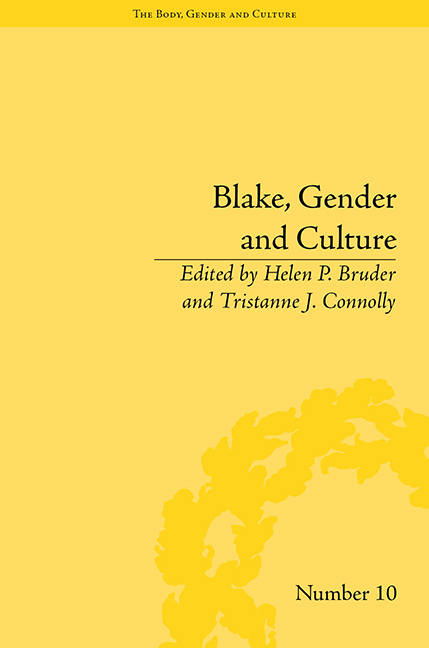Book contents
- Frontmatter
- CONTENTS
- Acknowledgements
- List of Contributors
- List of Figures
- Abbreviations
- Introduction: Naked History Displayed
- 1 ‘Merely a Superior Being’: Blake and the Creations of Eve
- 2 The Last Strumpet: Harlotry and Hermaphroditism in Blake's Rahab
- 3 Sex, Violence and the History of this World: Blake's Illustrations to the Book of Enoch
- 4 Bridal Mysticism and ‘Sifting Time’: The Lost Moravian History of Blake's Family
- 5 ‘A Secret Common to Our Blood’: The Visionary Erotic Heritage of Blake, Thomas Butts and Mary Butts
- 6 Changing the Sexual Garments: The Regeneration of Sexuality in Jerusalem
- 7 Philoprogenitive Blake
- 8 ‘Seeking Flowers to Comfort Her’: Queer Botany in Blake's Visions, Darwin's Loves and Wollstonecraft's Rights of Woman
- 9 ‘Or Wilt Thou Go Ask the Mole?’: (Con)Figuring the Feminine in Blake's Thel
- 10 Gendering the Margins of Gray: Blake, Classical Visual Culture and the Alternative Bodies of Ann Flaxman's Book
- 11 The Virgil Woodcuts Out of Scale: Blake's Gigantic, Masculine Pastoral
- 12 Closet Drama: Gender and Performance in Blake and Joanna Baillie
- Notes
- Works Cited
- Index
Introduction: Naked History Displayed
- Frontmatter
- CONTENTS
- Acknowledgements
- List of Contributors
- List of Figures
- Abbreviations
- Introduction: Naked History Displayed
- 1 ‘Merely a Superior Being’: Blake and the Creations of Eve
- 2 The Last Strumpet: Harlotry and Hermaphroditism in Blake's Rahab
- 3 Sex, Violence and the History of this World: Blake's Illustrations to the Book of Enoch
- 4 Bridal Mysticism and ‘Sifting Time’: The Lost Moravian History of Blake's Family
- 5 ‘A Secret Common to Our Blood’: The Visionary Erotic Heritage of Blake, Thomas Butts and Mary Butts
- 6 Changing the Sexual Garments: The Regeneration of Sexuality in Jerusalem
- 7 Philoprogenitive Blake
- 8 ‘Seeking Flowers to Comfort Her’: Queer Botany in Blake's Visions, Darwin's Loves and Wollstonecraft's Rights of Woman
- 9 ‘Or Wilt Thou Go Ask the Mole?’: (Con)Figuring the Feminine in Blake's Thel
- 10 Gendering the Margins of Gray: Blake, Classical Visual Culture and the Alternative Bodies of Ann Flaxman's Book
- 11 The Virgil Woodcuts Out of Scale: Blake's Gigantic, Masculine Pastoral
- 12 Closet Drama: Gender and Performance in Blake and Joanna Baillie
- Notes
- Works Cited
- Index
Summary
‘Art can never exist without Naked Beauty displayed’ (E275)
Blake has the power to get under people's skin. His passionately expressed sensual aesthetics guarantee it, whilst his still-growing cultural presence ensures that we often witness that provocative afterlife. Blake returns. The temperature rises. Take, as a striking example, the widely-read review of Tate Britain's recent re-staging of Blake's 1809 exhibition, by Brian Sewell, in the Evening Standard. This quintessential connoisseur, enraged by Blake's ‘vicious, ignorant and silly’ artistic judgements, lays into him – ‘cod-philosopher, cod-poet and cod-painter’ – with gusto, tellingly singling out the sexual aspect of Blake's aesthetic for especial censure:
The nude and semi-nude figures to which Blake was devoted were never, after his student years (and very rarely then), drawn from the live model, but were developed at an extreme remove from reality, creatures of mannerism inspired by fancy, their musculature as schematic and preposterous as that of notorious late 20th-century draughtsmen whose work is based on and encourages erotic fantasy.
When so many of his visions force nude figures into oddly sexual conjunctions and almost pornographic attitudes, the sceptical enquirer is perhaps allowed to question the mask of innocence.
Sexually knowing, coercive; enticing, inventive – Sewell, albeit with glorious disdain, homes in on just the hypnotic Blakean eroticism we have hotly pursued before and our contributors now chase through the halls of history, revealed to be far from dry and dusty.
- Type
- Chapter
- Information
- Blake, Gender and Culture , pp. 1 - 10Publisher: Pickering & ChattoFirst published in: 2014

